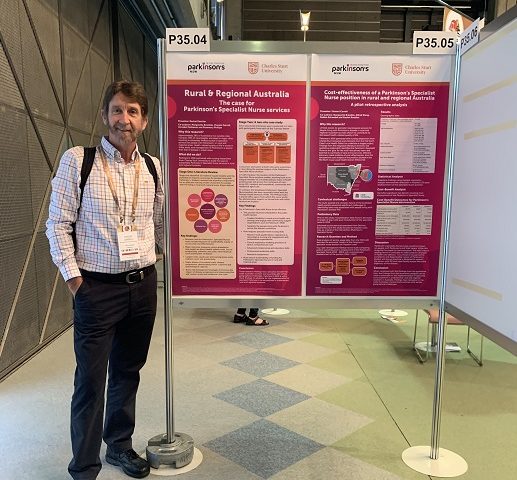Parkinson’s research partnership

Seeking support
2nd April 2021
Men and Parkinson’s
2nd April 2021Parkinson’s research partnership

Parkinson’s research partnership
In July 2017 Parkinson’s Specialist Nurse Vince Carroll spent four weeks at Neuroscience Research Australia (NeuRA) on a research placement program.
Vince’s is based in the Mid North Coast Local Health District (MNCLHD) and his position is 50/50 co-funded by the LHD and Parkinson’s NSW.
The research placement was described as “…an outstanding learning opportunity”.
Key outcomes of the program included enhancing research capacity of the staff involved and the forging of close collaborative links with research institutes.
As a result of Vince’s placement, he forged close relationships with a number of NeuRA researchers.
One of the researchers, Dr Lewis Ingram, at the time of Vince’ placement was a PhD candidate undertaking research on the upper limb.
With Vince’s involvement, NeuRA expanded the study to include people with Parkinson’s. This resulted in Parkinson’s NSW supporting NeuRA with the recruitment of participants into the study from Coffs Harbour.
The study partners included NeuRA, MNCLHD, Parkinson’s NSW and University of NSW.
The study has now been accepted for publication with PeerJ.
Reference
Ingram, L., Carroll, V., Butler, A., Brodie, M., Gandevia, S., & Lord, S. (2020) Quantifying upper limb motor impairment in people with Parkinson’s disease: A physiological profiling approach. Manuscript accepted for publication.
Abstract
Background: Upper limb motor impairments, such as slowness of movement and difficulties executing sequential tasks, are common in people with Parkinson’s disease (PD).
Objective: To evaluate the validity of the upper limb Physiological Profile Assessment (PPA) as a standard clinical assessment battery in people with PD, by determining whether the tests, which encompass muscle strength, dexterity, arm stability, position sense, skin sensation and bimanual coordination can (a) distinguish people with PD from healthy controls, (b) detect differences in upper limb test domains between “off” and “on” anti-Parkinson medication states and (c) correlate with a validated measure of upper limb function.
Methods: 34 participants with PD and 68 healthy controls completed the upper limb PPA tests within a single session.
Results: People with PD exhibited impaired performance across most test domains. Based on validity, reliability, and feasibility, six tests (handgrip strength, finger-press reaction time, 9-hole peg test, bimanual pole test, arm stability, and shirt buttoning) were identified as key tests for the assessment of upper limb function in people with PD.
Conclusions: The upper limb PPA provides a valid, quick, and simple means of quantifying specific upper limb impairments in people with PD. These findings indicate clinical assessments should prioritise tests of muscle strength, unilateral movement and dexterity, bimanual coordination, arm stability and functional tasks in people with PD as these domains are the most commonly and significantly impaired.



